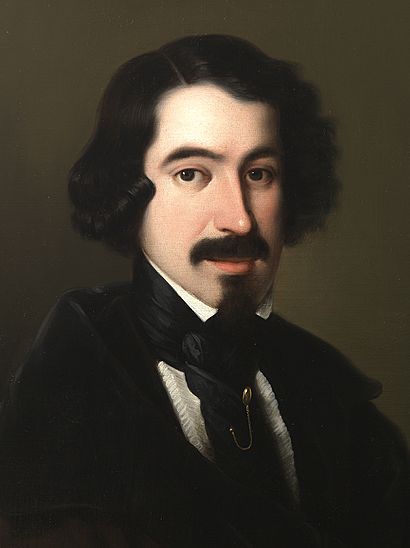El escritor José de Espronceda facts for kids
Quick facts for kids El escritor José de Espronceda |
|
|---|---|
 |
|
| Artist | Antonio María Esquivel |
| Year | 1842 |
| Movement | Romanticism |
| Dimensions | 72,7 × 56,2 cm |
| Location | Museo del Prado, Madrid |
El escritor José de Espronceda is a famous oil painting from 1842. It was created by the Spanish artist Antonio María Esquivel and is now kept at the Museo del Prado in Madrid. This painting is a portrait of the well-known Spanish poet José de Espronceda.
Contents
About the Painting
This painting shows the poet José de Espronceda. It's a great example of Romanticism, an art movement that was popular in the 1800s. Romanticism focused on strong emotions, individualism, and the beauty of nature.
Who Was José de Espronceda?
José de Espronceda (1808–1842) was one of the most important Spanish poets of the Romantic period. He was known for his passionate and sometimes rebellious writing. His poems often explored themes of freedom, love, and destiny. He lived a short but very active life, and his work greatly influenced Spanish literature.
The Artist: Antonio María Esquivel
Antonio María Esquivel (1806–1857) was a Spanish painter. He was famous for his portraits and religious paintings. Esquivel was a key artist in the Romantic movement in Spain. He was known for capturing the personality of the people he painted, and his portrait of Espronceda is a perfect example of his skill.
What is Romanticism?
Romanticism was a big movement in art, literature, and music that started in the late 1700s and lasted through the mid-1800s. It was a reaction against the strict rules of earlier art styles. Romantic artists and writers loved to show:
- Strong feelings and emotions
- The power and beauty of nature
- Individual heroes and their struggles
- Imagination and dreams
In Spain, Romanticism was very important, especially in poetry and drama. Espronceda's work fits perfectly into this style.
Where Else Can You See It?
There are other copies, called replicas, of this painting. You can find one at the Biblioteca Nacional de Madrid (National Library of Madrid) and another at the Ateneo de Madrid. These copies were made possible thanks to Manuel Arroyo.
Images for kids
See also
 In Spanish: El escritor José de Espronceda para niños
In Spanish: El escritor José de Espronceda para niños


